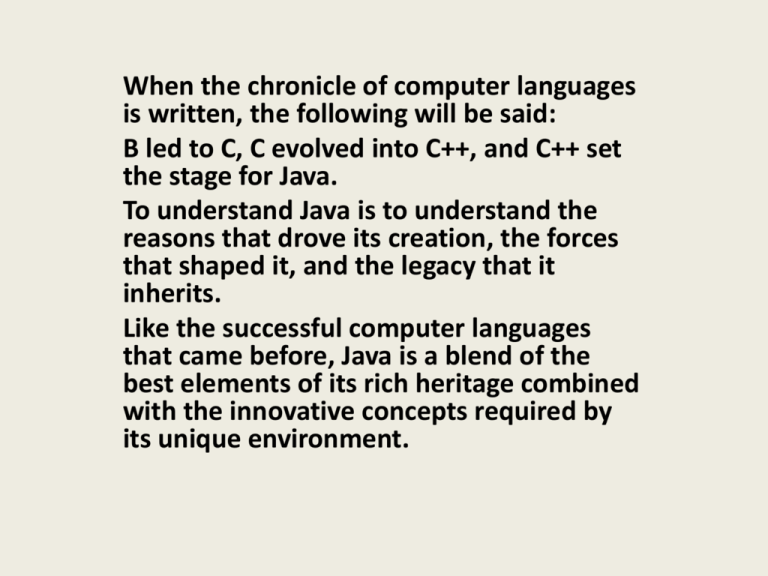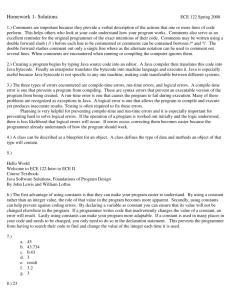Java run-time system
advertisement

When the chronicle of computer languages is written, the following will be said: B led to C, C evolved into C++, and C++ set the stage for Java. To understand Java is to understand the reasons that drove its creation, the forces that shaped it, and the legacy that it inherits. Like the successful computer languages that came before, Java is a blend of the best elements of its rich heritage combined with the innovative concepts required by its unique environment. • Computer language innovation and development occurs for two fundamental reasons: • ■ To adapt to changing environments and uses • ■ To implement refinements and improvements in the art of programming The Birth of Modern Programming: C • The C language shook the computer world. Its impact should not be underestimated, because it fundamentally changed the way programming was approached and thought about. • The creation of C was a direct result of the need for a structured, efficient, high level language that could replace assembly code when creating systems programs. • As you probably know, when a computer language is designed, trade-offs are often made, • such as the following: • ■ Ease-of-use versus power • ■ Safety versus efficiency • ■ Rigidity versus extensibility • Invented and first implemented by Dennis Ritchie on a DEC PDP-11 running the UNIX operating system, C was the result of a development process that started with an older language called BCPL, developed by Martin Richards. • BCPL influenced a language called B, invented by Ken Thompson, which led to the development of C in the 1970s. • For many years, the de facto standard for C was the one supplied with the UNIX operating system and described in The C Programming Language by Brian Kernigham and Dennis Ritchie (Prentice-Hall, 1978). • C was formally standardized in December 1989, when the American National Standards Institute (ANSI) standard for C was adopted. • The creation of C is considered by many to have marked the beginning of the modern age of computer languages. • It successfully synthesized the conflicting attributes that had so troubled earlier languages. • The result was a powerful, efficient, structured language that was relatively easy to learn. • It was a programmer’s language. • Prior to the invention of C, computer languages were generally designed either as academic exercises or by bureaucratic committees. • C is different. It was designed, implemented, and developed by real, working programmers, reflecting the way that they approached the job of programming. • Its features were honed, tested, thought about, and rethought by the people who actually used the language. • The result was a language that programmers liked to use. • Indeed, C quickly attracted many followers who had a near-religious zeal for it. As such, it found wide and rapid acceptance in the programmer community. • In short, C is a language designed by and for programmers. As you will see, Java has inherited this legacy. The Need for C++ • During the late 1970s and early 1980s, C became the dominant computer programming language, and it is still widely used today. Since C is a successful and useful language, you might ask why a need for something else existed. • The answer is complexity. • Throughout the history of programming, the increasing complexity of programs has driven the need for better ways to manage that complexity. • C++ is a response to that need. • To better understand why managing program complexity is fundamental to the creation of C++, consider the following. • By the early 1980s, many projects were pushing the structured approach past its limits. • To solve this problem, a new way to program was invented, called objectoriented programming (OOP). • Object-oriented programming is discussed in detail later in this book, but here is a brief definition: • OOP is a programming methodology that helps organize complex programs through the use of inheritance, encapsulation, and polymorphism. • C++ was invented by Bjarne Stroustrup in 1979, while he was working at Bell Laboratories in Murray Hill, New Jersey. • Stroustrup initially called the new language “C with Classes.” • However, in 1983, the name was changed to C++. • C++ extends C by adding object-oriented features. Because C++ is built upon the foundation of C, it includes all of C’s features, attributes, and benefits. • This is a crucial reason for the success of C++ as a language. • The invention of C++ was not an attempt to create a completely new programming language. • Instead, it was an enhancement to an already highly successful one. The Creation of Java • Java was conceived by James Gosling, Patrick Naughton, Chris Warth, Ed Frank, and Mike Sheridan at Sun Microsystems, Inc. in 1991. It took 18 months to develop the first working version. • This language was initially called “Oak” but was renamed “Java”in 1995. • Between the initial implementation of Oak in the fall of 1992 and the public announcement of Java in the spring of 1995, many more people contributed to the design and evolution of the language. • Bill Joy, Arthur van Hoff, Jonathan Payne, Frank Yellin, and Tim Lindholm were key contributors to the maturing of the original prototype. • Somewhat surprisingly, the original impetus for Java was not the Internet! Instead, the primary motivation was the need for a platform-independent (that is, architecture neutral) language that could be used to create software to be embedded in various consumer electronic devices, such as microwave ovens and remote controls. • As you can probably guess, many different types of CPUs are used as controllers. The trouble with C and C++ (and most other languages) is that they are designed to be compiled for a specific target. • Although it is possible to compile a C++ program for just about any type of CPU, to do so requires a full C++ compiler targeted for that CPU. • The problem is that compilers are expensive and time-consuming to create. • An easier—and more cost-efficient—solution was needed. In an attempt to find such a solution, Gosling and others began work on a portable, platform-independent language that could be used to produce code that would run on a variety of CPUs under differing environments. This effort ultimately led to the creation of Java. Java Applets and Applications • • • • • • • • • • • • Java can be used to create two types of programs: applications and applets. An application is a program that runs on your computer, under the operating system of that computer. (That is, an application created by Java is more or less like one created using C or C++. When used to create applications, Java is not much different from any other computer language.) Rather, it is Java’s ability to create applets that makes it important. An applet is an application designed to be transmitted over the Internet and executed by a Java-compatible Web browser. An applet is actually a tiny Java program, dynamically downloaded across the network, just like an image, sound file, or video clip. The important difference is that an applet is an intelligent program, not just an animation or media file. In other words, an applet is a program that can react to user input and dynamically change—not just run the same animation or sound over and over. As exciting as applets are, they would be nothing more than wishful thinking if Java were not able to address the two fundamental problems associated with them: security and portability. Before continuing, let’s define what these two terms mean relative to the Internet. Java’s Magic: The Bytecode • The key that allows Java to solve both the security and the portability problems just described is that the output of a Java compiler is not executable code. Rather, it is Bytecode. • Bytecode is a highly optimized set of instructions designed to be executed by the Java run-time system, which is called the Java Virtual Machine (JVM). That is, • in its standard form, the JVM is an interpreter for Bytecode. • This may come as a bit of a surprise. As you know, C++ is compiled to executable code. • In fact, most modern languages are designed to be compiled, not interpreted—mostly because of performance concerns. • However, the fact that a Java program is executed by the JVM helps solve the major problems associated with downloading programs over the Internet. Here is why. • Translating a Java program into bytecode helps makes it much easier to run a program in a wide variety of environments. • The reason is straightforward: only the JVM needs to be implemented for each platform. • Once the run-time package exists for a given system, any Java program can run on it. • Remember, although the details of the JVM will differ from platform to platform, all interpret the same Java bytecode. • If a Java program were compiled to native code, then different versions of the same program would have to exist for each type of CPU connected to the Internet. • This is, of course, not a feasible solution. Thus, the interpretation of bytecode is the easiest way to create truly portable programs. • The fact that a Java program is interpreted also helps to make it secure. Because the execution of every Java program is under the control of the JVM, the JVM can contain the program and prevent it from generating side effects outside of the system. • As you will see, safety is also enhanced by certain restrictions that exist in the Java language. • When a program is interpreted, it generally runs substantially slower than it would run if compiled to executable code. However, with Java, the differential between the two is not so great. • The use of bytecode enables the Java run-time system to execute programs much faster than you might expect. • Although Java was designed for interpretation, there is technically nothing about Java that prevents on-the-fly compilation of bytecode into native code. • Along these lines, Sun supplies its Just In Time (JIT) compiler for bytecode, which is included in the Java 2 release. • When the JIT compiler is part of the JVM, it compiles bytecode into executable code in real time, on a piece-by-piece, demand basis. • It is important to understand that it is not possible to compile an entire Java program into executable code all at once, because Java performs various run-time checks that can be done only at run time. • Instead, the JIT compiles code as it is needed, during execution. • However, the just-in-time approach still yields a significant performance boost. Even when dynamic compilation is applied to bytecode, the portability and safety features still apply, because the run-time system (which performs the compilation) still is in charge of the execution environment. • Whether your Java program is actually interpreted in the traditional way or compiled on-the-fly, its functionality is the same. The Java Buzzwords • No discussion of the genesis of Java is complete without a look at the Java buzzwords. • Although the fundamental forces that necessitated the invention of Java are portability and security, other factors also played an important role in molding the final form of the language. The key considerations were summed up by the Java team in the • following list of buzzwords: • ■ Simple • ■ Secure • ■ Portable • ■ Object-oriented • ■ Robust • ■ Multithreaded • ■ Architecture-neutral • ■ Interpreted • ■ High performance • ■ Distributed • ■ Dynamic




